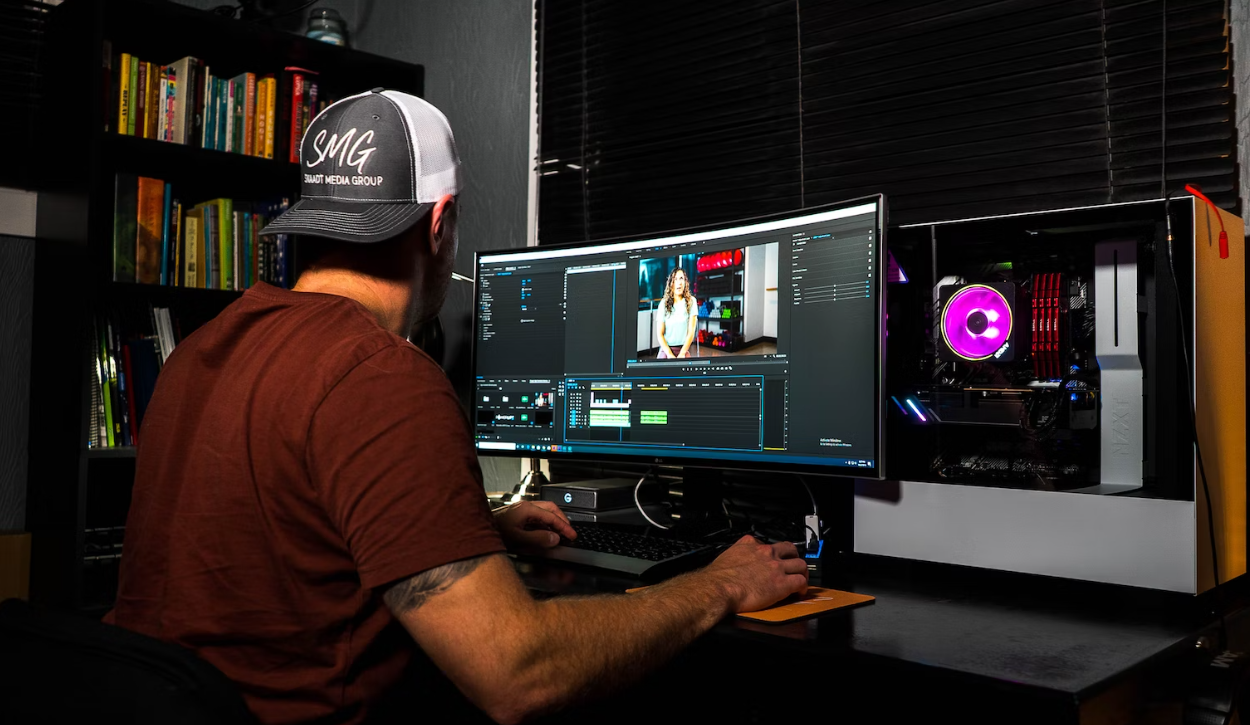Choosing a CPU for video editing means a balance of power between your processor and other essential components. For starters, video editing – or NLEs (Non-linear Editing) – applications like Adobe Premiere Pro, DaVinci Resolve and Sony Vegas are known for their heavy workloads when compressing, encoding and decoding video. Whilst it is true that you need a powerful creator PC to ensure you have an efficient, smooth workflow, you also need to understand why the specification is right for your particular needs.
Whether you are a video editor or a videographer, knowing the differences between motherboards, CPUs and GPUs is critical, as applications and video encoding all have their own pros and cons with different hardware. Furthermore, the specification for a video editor and a videographer will be different.
This guide will clarify which CPU (processor) is right for you – regardless of whether you’re a professional who is both shooting and editing, or just editing videos.
Differences between video editors and videographers
Before we get into anything technical or look at any specifications, it is important to cover this first. There is a huge difference between video editing and videography when it comes to choosing a workstation or creator PC. The two are mutually exclusive, because video editors must have a very versatile specification that can handle multiple video formats, where a videographer who does their own editing will know in advance which formats, codecs and workloads they will consistently use.
A video editing PC
Playback and exporting/rendering.
If you are a video editor who receives raw footage from various sources and clients, editing and producing final versions for different platforms/media, you will need to have a specification that is an all rounder. That won’t always mean you have the best CPU for the job, but you will certainly have enough computational resources to process, edit and render footage if you choose wisely.
Video playback is a key strength for video editors, as is rendering and exporting.
A videographer PC
Encoding and transcoding.
Knowing exactly which formats you are going to use and edit is a big win when you’re building or buying a video editing PC. H.264, H.265, AV1, HEVC and other codecs play the biggest role in performance and PC hardware efficiency, so if you already know which of these you will shoot footage in, or edit predominantly, then half of the battle is won.
If you shoot in raw formats, your CPU will bear the brunt of the encoding in applications like Handbrake or in video editing applications, so this is a factor in CPU choice.
Which CPU is best?
Video editors
Overall, the best CPU for video editing is the Intel Core i9 12900K. In rendering tests using Premier Pro, Puget Systems saw as much as a 25 – 40% performance lead with Intel, against AMD 5000 series processors. Further, when using popular codecs such as H.264 and HEVC, Intel has significant benefits over AMD. With the launch of the 13th-Gen Raptor Lake processors, Intel are likely to strengthen their creator market share, with suggested 30% increases in performance over last-gen CPUs.

Videographers
This article would be much shorter if we could just say “Intel are the best overall”, but AMD do have their own – quite incredible – merits. For example, the AMD 7000 series of processors are highly adept at exporting or rendering 4K RED files in Adobe Premiere Pro, and for general workflow and rendering in Adobe After Effects and DaVinci Resolve, the Ryzen 9 7950X has a significant lead.

The new Zen 4 processors from AMD are making short work of productivity and creative workloads, so they cannot be discounted by videographers, who will surely put them through their paces in large format renders. All in all, new Zen 4 processors have increased performance in video editing by as much as 50%, which is remarkable by anyone’s standards.
Best CPUs for video editing and videographers
As discussed, there are a few factors to consider whether you are an editor or a videographer when it comes to specification. Below we have outlined three CPUs that are idea for both types of user, and some example specifications for each price range.
Besides your processor, there are other components that will round out the system performance, and ensure it runs smoothly.
Not only will the CPU take on the heavy workload, but GPU power, memory and storage also come into play. Video editing should also take into consideration any post-production work done in After Effects, which relies on the GPU capabilities in the specification. Memory is a critical component, as your system will need to temporarily store data on the large files as you work on them – DDR5 is preferable, but Intel 12th-Gen and 13th-Gen has shown good performance in DDR4, too. For storage, the best option for creators is having an SSD for your operating system and main applications (NLEs such as Adobe Premiere pro etc), and a large capacity HDD storage for long term storage.
If you have these components nailed down, you can then match with a processor from the below options.
Heavy workload: AMD Ryzen 9 7950X
This processor is ideal for extremely heavy work such as 4K and 8K editing and rendering, but also post-production effects work. On balance, the Zen 4 Ryzen 9 7950X has superior performance over rivals in NLEs that are resource hungry. With outstanding benchmarks in Premiere Pro, After Effects, DaVinci Resolve and Lightroom. The Ryzen 9 7950X is the most powerful consumer chip in October 2022, with 16 Cores and 32 Threads, a max boost clock Up to 5.7 GHz, and a base clock of 4.50 GHz.

The Ryzen 7950X is best paired with a higher spec graphics card (RTX 3060 or better) to fully take advantage of post-production and effects in NLEs, and you will need to choose DDR5 for your specifications as AM5 does not support DDR4. This is not a terrible thing, considering how well the CPU performs with DDR5 memory.
All rounder: Intel Core i9-12900K
The Intel Core i9-12900K offers up a wealth of experience with Intel’s knowledge of encoding and video codecs, making it ideal for all types of video editing. In benchmarks, the 12900K has been extremely dominant over last-gen Intel and AMD processors, and is close to the new Zen 4 AMD processors, too, in post-production and editing software.
With 16 Cores and 24 Threads, a 3.2GHz base clock and 5.2GHz turbo, the i9-12900K has huge power at its disposal. Many of the background tasks that can often clog up a workflow are handled by the 8 Efficient-cores , whilst the bulk of the work is distributed to 8 Performance-cores, using Intel’s hybrid architecture launched with Alder Lake.

When paired with an RTX graphics card such as the RTX 3060, and sizeable RAM, you will ensure you have enough in the tank for large format, high resolution editing and rendering, as well as post-production work. The specification in the Chillblast Create Core Pro Editing PC offers the above, with the following specification: –
- Processor: Intel Core i9-12900K CPU
- Graphics Card: NVIDIA GeForce RTX 3060 12GB Graphics Card
- Memory: 64GB DDR4 3200MHz Memory
- Motherboard: ASUS PRIME Z690-P WIFI D4 Motherboard
- CPU Cooler: Noctua NH-D15S Chromax Black CPU Cooler
- Storage: 1TB Seagate Firecuda 530 M.2 PCIe Gen 4 Solid State Drive
Budget-focused: Intel Core i5-12600K
With 6 Performance-cores and 4 Efficient-cores, the Core i5-12600K is an excellent workhorse for video editing, having a base clock speed of 3.70 GHz, and turbo of 4.90 GHz. Using Thread Director, the 12600K can distribute resources to intensive and background tasks as required, meaning you are always working at peak efficiency.
For video editors who are not performing lots of post-production work, an RTX 3050 will suffice as a graphics card, and an RTX 3060 or better will suit those creating lots of effects. A decent amount of RAM will be required to hand off any pressure whilst working on files, as this will further enhance the efficiency of the Alder Lake CPU.

The Chillblast Marine RTX 3050 is a great example of a budget video editing PC, with a stacked specification that is just as comfortable editing videos as hitting high framerates in the latest games.
- Processor: Intel Core i5-12600K
- Operating System: Windows 11 Home
- Graphics Card: NVIDIA GeForce RTX 3050 8GB
- Memory: 16GB DDR4 3200MHz
- Motherboard: Gigabyte B660M DS3H AX D4 Motherboard
- CPU Cooler: Noctua NH-U9S Chromax Black CPU Cooler
- Storage: 500GB M.2 Gen 4 Solid State Drive
Don’t forget, Chillblast have been making video editing PCs for over 20 years, tailoring specifications to suit the needs of creative professionals around the world. As the UK’s number 1 PC builder, and most awarded PC manufacturer, we’ll customise your PC specifically for your needs. Design your custom PC with us.






